The Acer Swift 3 SF314 Notebook Review: Swift Gets Swifter With Ryzen 4000
by Brett Howse & Andrei Frumusanu on May 5, 2020 8:00 AM ESTSystem Performance
AMD’s new Renoir platform has already been showcased in our SPEC testing, which made a clear case that the new design provides a much-needed performance bump over the previous Picasso platform. Despite the individual cores having generally lower single-threaded performance than Intel’s Ice Lake, they make up for that deficiency with sheer volume, doubling the core count of the competition. AMD’s mantra for the entire Zen existence has been more for less, and that continues here again. Acer has positioned this laptop at an entry-level price, but with performance that should meet or exceed other devices in its class.
Both AMD based models of this 14-inch Acer Swift 3 come with 8 GB of RAM, in the DDR4-3200 flavor, which is where notebooks need to be these days for an entry position, so it was nice to see them offer 8 GB on both the Ryzen 5 and Ryzen 7 models. The company could have cut back to hit an even lower price point, especially on the Ryzen 5, but that would impact the performance too much to make it a worthwhile compromise. They’ve also started with a 256 GB SSD on the Ryzen 5 model, and bumped that up to 512 GB on the Ryzen 7 we have here, and still at just $649, which is fantastic value and should keep the target market happy for some time.
To see how the Acer Swift 3 with Ryzen 7 4700U performs, we have run it through our laptop test suite and compared it to several other similar systems. If you'd like to compare the Acer Swift 3 to any other laptop we have tested, please check out our online Bench.
PCMark
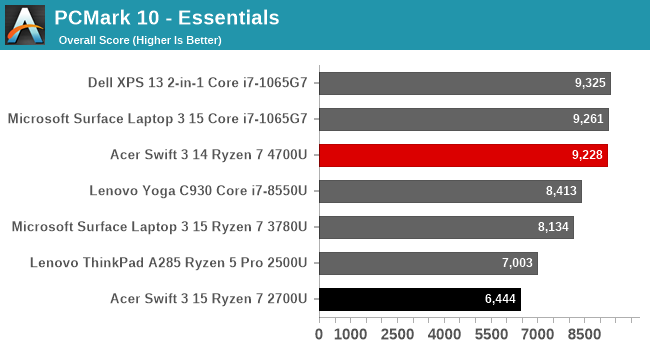
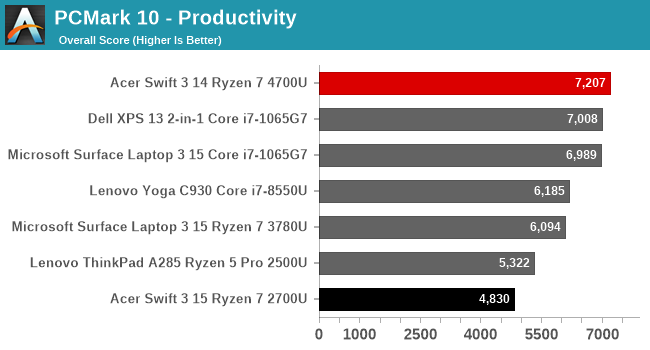
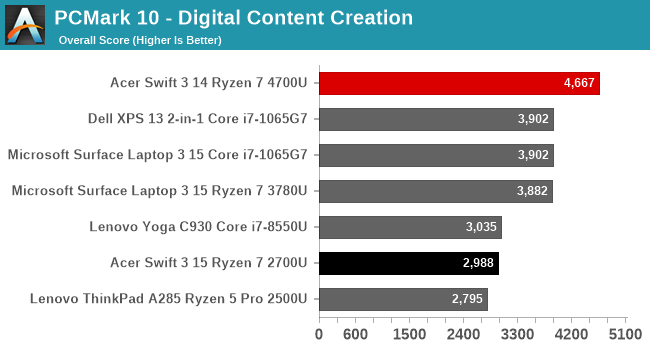
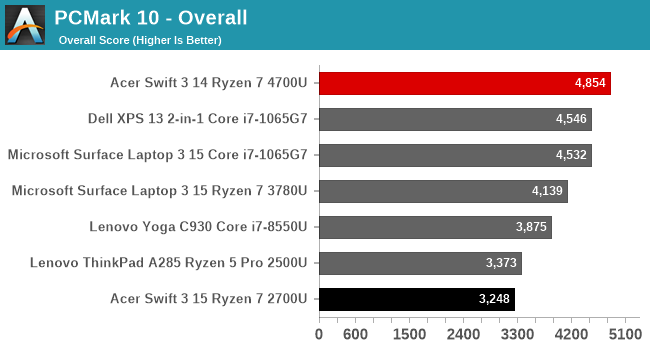
UL’s PCMark suite offers some real-world test cases, and tests all aspects of the system, from CPU performance, to GPU, to even app-loading times and disk performance. The Acer Swift 3 performs very well here, especially in the digital content creation sub-tests, where the GPU gets to showcase some of its prowess.
Cinebench R20
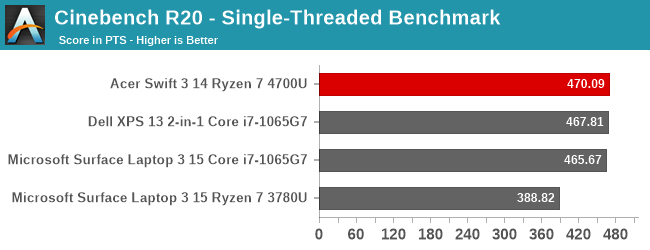
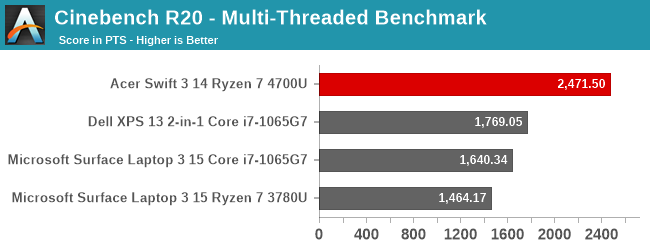
AMD has been touting its Cinebench results for some time since their launch of Zen, and for good reason. As a compute-focused test, the Zen 2 cores perform very well here, and having eight physical cores in the multithreaded results really make the Ryzen 7 4700U stand out. SMT has been a great way to get more performance per-core, but there is still no substitute for actual cores.
x264

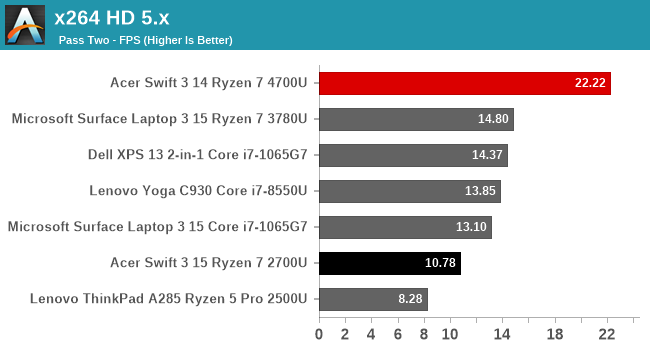
The x264 test transcodes a video using the CPU and has always enjoyed more CPU performance and more CPU cores, so it should not surprise anyone that the Ryzen 7 4700U wins the day here again. Eight cores make short work of this transcode.
Handbrake
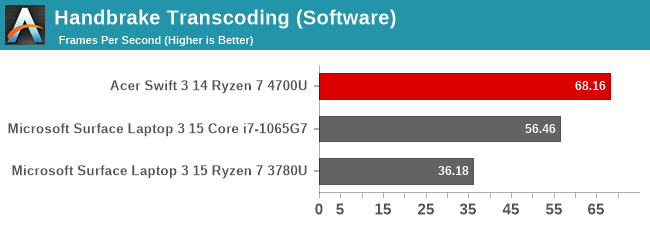

Handbrake is arguably the most popular video transcode tool around, and it offers both software-based CPU transcoding, as well as GPU accelerated. On our last Picasso platform, the Microsoft Surface Laptop 3, Handbrake wasn’t able to leverage Vega’s Video Core Next hardware, however the Acer Swift 3 can, and in both software and hardware encoding, the Renoir based Acer Swift 3 finishes this task very quickly.
7-Zip
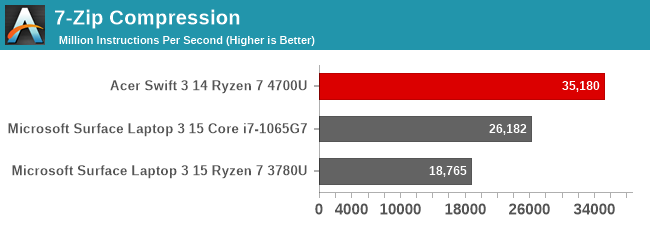
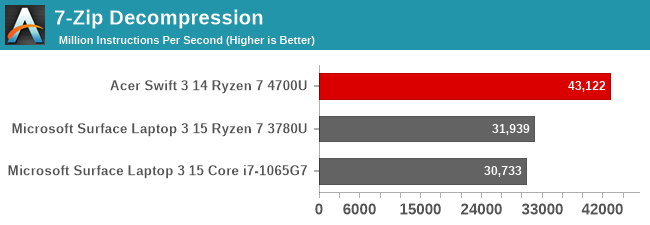
7-Zip is a very popular, free file compression and extraction tool, and it also offers a built-in benchmark. AMD’s Renoir SoC once again outperforms the rest of the 15-Watt systems here. Tests such as this and transcode do very well with the extra cores provided on the Ryzen 7 4700U.
Web Benchmarks
This will likely be our last review with the older web tests. Web benchmarks are as much about the browser’s scripting engine as they are about pure CPU performance, so for consistency we’ve tested in Microsoft Edge. Now that Edge is being moved to the new Chromium-based version, we’ll take this opportunity to replace some of our older tests.
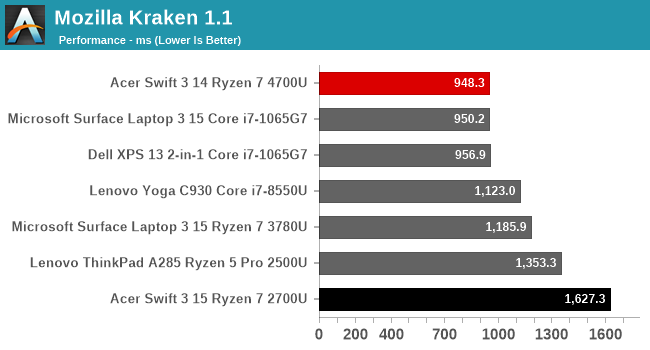
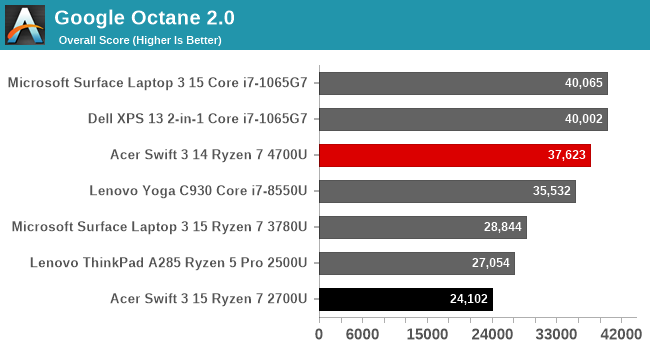
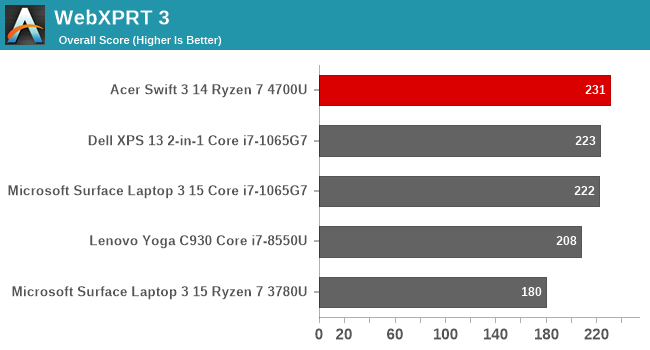
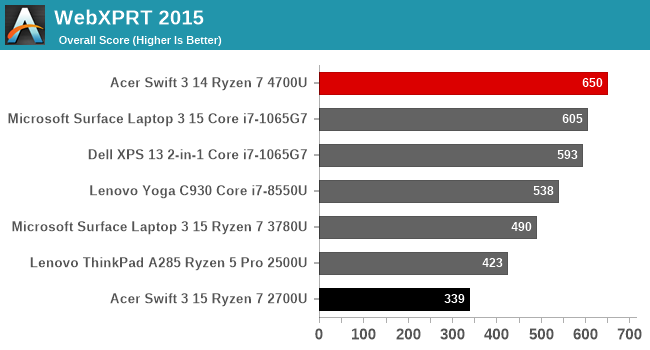
Web tests also tend to be more sensitive to the CPU being able to ramp up its frequency quickly, and that is an area where AMD’s systems did not perform quite as well. Luckily for Renoir, those issues are behind AMD, and the Acer Swift 3 performs very well.
Storage
One of the best things about the Acer Swift 3 is how much storage it comes with considering its price point. The review unit offers 512 GB of SSD storage, and although you may expect slower, cheaper SATA storage here, that is not the case. The Acer Swift 3 ships with NVMe PCIe 3.0 x4 storage, and in the case of the review unit, that means a Samsung PM991 SSD inside.
Performance is excellent. Despite this being a budget notebook, the storage options are very welcome. A base model offering 256 GB is a great start, but a proper NVMe SSD as well makes this laptop even more value.
System Performance Conclusion
Although AMD has really made inroads in the desktop space since the launch of Zen, in the laptop space where power is at a premium, what made the early Zen based APUs stand out was not the CPU but the GPU. Since then, Intel released Ice Lake, offering similar GPU performance but with much higher CPU performance. Now that AMD is on their third-generation of Zen-based laptop APUs, that performance lead has all but evaporated. In our SPEC results, Intel still has the single-threaded lead, but AMD more than makes up for that by offering eight CPU cores, compared to just four on Ice Lake. The Ryzen 7 4700U that Acer has fitted into this Swift 3 is likely to be one of the more popular options, and for good reason. Despite it not offering SMT, the performance is fantastic.


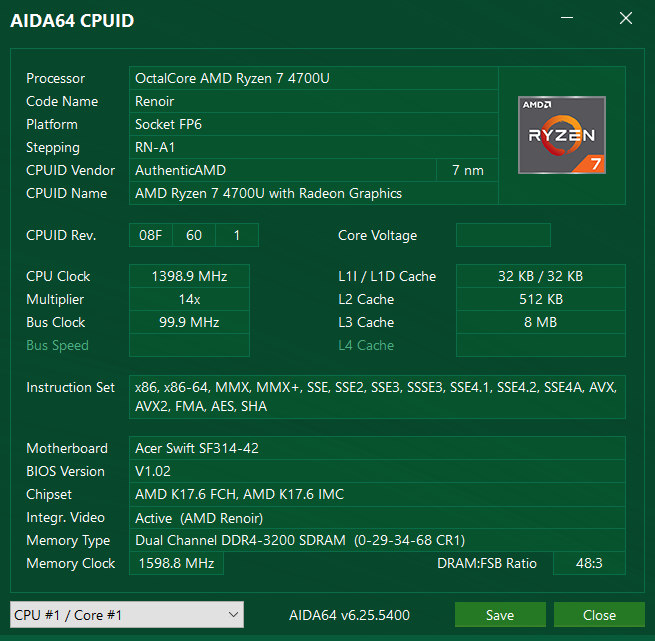









191 Comments
View All Comments
fmcjw - Tuesday, May 5, 2020 - link
Because over in Mac land they finally got the butterfly keyboard revolt over with and now talks can resume on the finer points of systems design. But it's not looking good for fine arts because the front burners have been conscripted for the A15 (MacOS on ARM) revolution.Spunjji - Wednesday, May 6, 2020 - link
Buying a CPU that doesn't have turbo is *not* a worthy trade-off unless you simply cannot afford anything better, because you'll be leaving a whole ton of performance on the table - especially when the device is plugged in.The 25% battery deficit isn't as simple as "more cores, more power" either - check out the Zephyrus G14 vs the Razer Blade 15 for a more appropriate comparison of well-designed devices. Put simply, that deficit has more to do with how this particular notebook was designed than it does to do with Ryzen 4000.
Focusing on single-thread performance when the vast majority of applications users interact with are multi-threaded doesn't really make sense, either. I'd recommend reading in a little more depth.
Omega215D - Tuesday, May 5, 2020 - link
Looks like we've got another piece of crap Intel fanboy here intent on spreading FUD on AMD's new mobile processors. So far reviews of the ASUS TUF featuring the new procs do far better on battery life and gaming performance.yeeeeman - Tuesday, May 5, 2020 - link
Looks like we've got another piece of crap AMD fanboy that cannot read the damn graphs.yankeeDDL - Tuesday, May 5, 2020 - link
The XPS and the Surface cost about twice as much as the Swift 3: they are high-end systems with high-end components, especially screens.Irata - Tuesday, May 5, 2020 - link
Actually the Dell's "as reviewed" price on At was $ 1,749.99, the Surface Laptop 3 with a 512GB SSD costs $ 2,199, so we are talking three times the price. The Yoga C930 is almost budget, costing only slightly less than twice as much as the Swift.yankeeDDL - Wednesday, May 6, 2020 - link
Thanks. You're right of course.Irata - Tuesday, May 5, 2020 - link
Eight cores vs. four cores....You have surely seen the battery life comparisons between Ryzen 4000 and Intel's eight core counterpart.
notb - Wednesday, May 6, 2020 - link
Number of cores is of less importance. Intel makes 16-core processors using 30W and 6-core chips using 100W.Comparison of 8-core SoCs are between chips made on TSMC 7N and Intel 14nm, which makes AMD much more efficient.
This comparison is for TSMC 7N vs Intel 10nm.
What matters is performance vs power and average these are similar. The gap will be minimal when Intel launches 6 or 8-core models later this year.
Spunjji - Wednesday, May 6, 2020 - link
Is there any evidence that Intel will be releasing 10nm 15W 6-8 core CPUs this year? I thought they were sticking with 4 cores on 10nm and releasing 6-8core 15W 14nm CPUs.